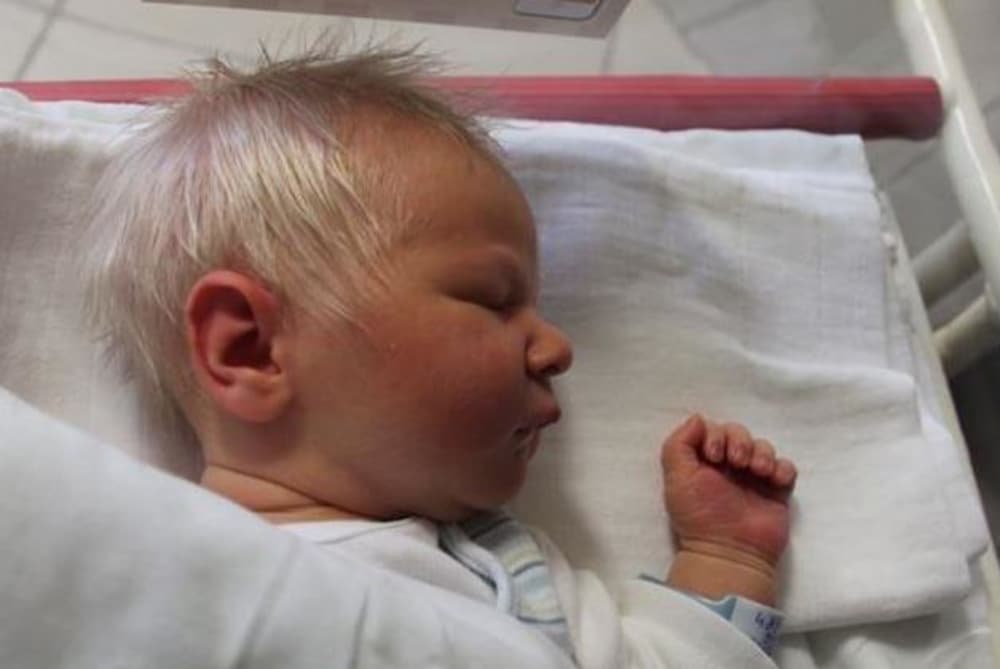
The Extraordinary Arrival: A Baby Born with a Crown of White
In the realm of human biology, where genetic marvels unfold, the birth of a baby with white hair is an extraordinary occurrence that captivates the imagination. These rare and captivating infants, often referred to as "snow babies," enter the world with a unique and striking appearance that sets them apart from their peers.
A Journey into the Realm of Genetics
The phenomenon of white hair in newborns is rooted in genetics, specifically in the absence of melanin, the pigment responsible for imparting color to hair, skin, and eyes. Melanin production is regulated by a complex interplay of genes, and when certain genetic variations occur, the body’s ability to produce melanin is compromised.
In the case of babies born with white hair, a mutation in the TYR gene, which encodes the enzyme tyrosinase, is often implicated. Tyrosinase is essential for the production of melanin, and its absence or dysfunction leads to a condition known as albinism.
Albinism: A Spectrum of Variations
Albinism encompasses a range of genetic disorders characterized by a deficiency or complete absence of melanin. This can manifest in various forms, including oculocutaneous albinism (OCA), which affects both the skin and eyes, and ocular albinism (OA), which primarily affects the eyes.
OCA is further classified into four main types, each with its own unique genetic basis and varying degrees of melanin production. Type 1 OCA, the most severe form, results in the complete absence of melanin, leading to white hair, pale skin, and blue or light-colored eyes.
Beyond Albinism: Other Causes of White Hair in Newborns
While albinism is the most common cause of white hair in newborns, it is not the only one. Other factors that can contribute to this unusual trait include:
- Piebaldism: A rare genetic condition characterized by patches of white skin and hair, often accompanied by white eyelashes and eyebrows.
- Waardenburg syndrome: A genetic disorder that affects the development of the inner ear, skin, and hair, sometimes resulting in white forelocks or patches of white hair.
- Tuberous sclerosis: A genetic disorder that causes the formation of non-cancerous tumors in various organs, including the brain and skin. White hair can be a symptom of this condition.
The Health Implications of White Hair in Newborns
The presence of white hair in newborns does not typically pose any significant health concerns. However, individuals with albinism may experience certain health challenges related to their reduced melanin production.
- Vision problems: Albinism can cause a range of vision problems, including nystagmus (involuntary eye movements), photophobia (sensitivity to light), and reduced visual acuity.
- Skin sensitivity: Individuals with albinism have highly sensitive skin that is prone to sunburn and skin cancer.
- Hearing loss: Some types of albinism can be associated with hearing loss.
Caring for Babies with White Hair
Parents of babies born with white hair should take extra precautions to protect their delicate skin and eyes. This includes:
- Sunscreen: Applying sunscreen with a high SPF (30 or higher) to exposed skin is crucial to prevent sunburn and skin cancer.
- Protective clothing: Wearing hats, sunglasses, and long-sleeved clothing can help shield the skin from harmful UV rays.
- Eye protection: Sunglasses with UV protection are essential to protect the eyes from light sensitivity and damage.
- Regular eye exams: Regular eye exams are recommended to monitor vision and detect any potential problems early on.
Embracing the Uniqueness
While the presence of white hair in newborns can be a source of curiosity and concern, it is important to remember that these children are just as special and deserving of love and care as any other child. Their unique appearance should not define them but rather be celebrated as a testament to the extraordinary diversity of human life.
Conclusion
The birth of a baby with white hair is a captivating event that sparks wonder and fascination. While genetics plays a significant role in this unusual trait, it is essential to understand the potential health implications associated with albinism and other underlying conditions. With proper care and support, these extraordinary children can thrive and live fulfilling lives, embracing their unique beauty and the boundless possibilities that lie ahead.
